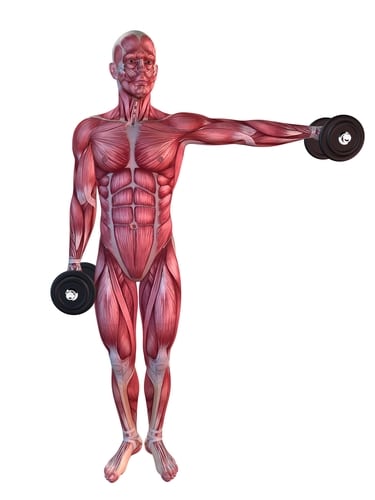
Muscle imbalances are common in most people, even in world-class athletes. The front of the legs (quadriceps) is quite often stronger than the back of the legs (hamstrings). In the back, the upper trapezius is usually stronger than the lower trapezius. Front delts are stronger than rear delts.
We usually favor working muscles we can see and that means we quite often overdevelop muscles on our front side. Our shoulders are a classic example of this. Your shoulder joint is probably the most versatile and heavily used joint in your body. No wonder that 30% of all strength training injuries happen to this joint.
Your Shoulder muscles can be divided into three groups:
1. Anterior Deltoid – located in the front of each shoulder
2. Lateral Deltoid – the middle part of your shoulder
3. Posterior Deltoid – Back part of your shoulder
Interestingly, a study that compared the shoulder strength of bodybuilders to sedentary people found that the bodybuilders had anterior deltoids (front) that were 500% stronger than people who didn’t work out. They also had lateral deltoids (middle) that were 300% stronger when compared to the sedentary group. But get this! The body builder’s posterior delts (back) were only 15% stronger!
Muscle imbalances between the front and rear delts can partly be explained by the over-emphasis of exercises that work the anterior delt and the lack of selecting exercises for the posterior delt. Pressing movements like bench presses and pushups are among the favorite and most used exercises by most people who work out, but as far as the shoulder muscles are concerned these exercises usually favor the anterior delts.
To really work the posterior delts you need to mainly select isolation exercises that specifically work this area of the shoulder. Many people just skip exercises for the rear delts because of time constraints and lack of interest in working such a small muscle they know little about.
Even people that workout a lot, like bodybuilders, and regularly perform exercises for the rear delts will tell you that the posterior delt is a very difficult muscle to work. You have to pay attention to strict form when working your rear delts so that other larger muscles don’t take over and power the movement. This is the reason why we just focus on rear delts as the only upper body muscle we work after training the lower body in several of the XTRAIN workouts. Just make sure you use a weight that is not too heavy.
So Why Should You Care About Your Rear Delts?
Most of us lead a lifestyle at work and home that is a lot more sedentary than our ancestors did. We spend a lot of our time slouching in our chair with our arms in front of us typing on our computer. This can lead to poor posture as our shoulders become acclimated to this poor posture position.
On the other hand, having well defined symmetrical shoulders not only looks good, but they will also help to reduce injuries, improve your posture and even make your waist look slimmer!
Modern workout trends like kettlebell workouts and metabolic training can contribute to shoulder imbalance problems because they use a lot of movements that put additional stress on the shoulder muscles and joints. Many of these movements place the greatest emphasis on the anterior delt. This can lead to an even greater muscle imbalance between the anterior and posterior delts and may also lead to an overuse shoulder injury.
The bench press and the shoulder press account for the highest percentage of injuries in strength training programs. Not surprisingly, both of these exercises involve the shoulder muscles. An injury to a shoulder joint can interrupt your training program for weeks and even months. All the more reason to make sure you XTRAIN and work on your shoulders muscles imbalances.
Deltoids Training Tip
When you do a dumbbell lateral raise the more you lean forward the more emphasis you place on the back of your shoulder. A 10 – 20-degree tilt is a nice angle to work the area between the middle and rear delt. Also, make sure to turn your pinking upwards at the top of the movement like you’re pouring a picture of water to hit the rear delts just a little more.
Bend your body to 90 degrees and you’re mainly working your rear delts. And here is another important tip. If you can’t pause the weight at the top of the movement for a lateral raise or a rear delt and hold it for at least the first few reps, then the weight is too heavy and chances are you’re using other larger muscles in the back to power the movement instead of the delt muscles you should be trying to work.
References:
2009. J Strength Cond Res. 23(1): 148-57
The Strength Training Anatomy Workout II, Frederic Delavier and Michael Gundill
Related Articles By Cathe:
The Part of Your Shoulders You’re Probably Not Training Hard Enough
Building Strong and Beautiful Shoulders: is Your Shoulder Workout Balanced?
Are You Making These Mistakes When You Do Overhead Presses?
Rounded Shoulders? It’s Probably Weakness in These Two Muscles
Hunched Shoulders – What Causes Them and How to Correct Them?
The Best Exercises for Broader Shoulders
Narrow Shoulders? What’s the Best Training to Make Them Look More Defined?
Problems Caused by Rounded Shoulders and How to Correct Them
Common Shoulder Problems: Keeping Your Shoulders Healthy When You Lift Weights
Related Cathe Friedrich Workout DVDs:
STS Strength 90 Day Workout Program
All of Cathe’s Strength & Toning Workout DVDs
Total Body Workouts
Upper Body Workouts

